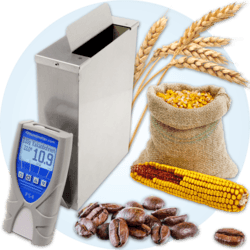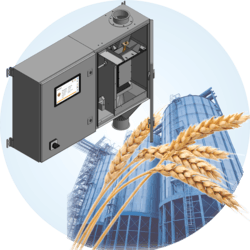Maize, rye, triticale, wheat, spelt, barley, oats, rape, pumpkin seeds, peas, soybeans, scarlet runner beans, horse beans, sunflower seeds, peeled, unpeeled and brown rice, poppy seeds, peeled and unpeeled raw coffee, roast and ground coffee, cocoa beans, linseed, sesame, sorghum, buckwheat, hops, bales of alfalfa, silo bales
Why you should prefer a whole grain moisture meter instead of other methods of moisture measurement?
The use of large sample volumes provides a safe and considerably more accurate average result than other methods of measurement requiring the grinding of small test samples. With this small test samples only one little unripe spelt grain is enough to falsify the measuring result significantly.
This will not happen if you use whole grain moisture meters like the humimeter devices due to the fact that this moisture meters use bigger sample sizes which guarantee precise measuring results with the easiest handling!
Comparsion
| Device | Resolution | Calibrate accuracy | Measuring range | Customer calibrations | Sample weight | Scale | Temperature | Data storage | PC Software + Onlinefunctionality |
|---|---|---|---|---|---|---|---|---|---|
| FS1.1 | 0,1% | 0,9% | 5 - 25% | 60g | X | X | |||
| FS1 | 0,1% | 0,7% | 5 - 30% | 60g | X | X | |||
| FS2 | 0,1% | 0,4% | 5 - 40% | 300g | X | X | X | ||
| FS3 | 0,1% | 0,4% | 0 - 40% | 300g | X | X | X | optional | |
| FS4 | 0,1% | 0,4% | 0 - 50% | X | 300g | X | X | X | X |
| FL1 | 0,5% | 1,0% | 8 - 40% | X | |||||
| FL2 | 0,1% | 0,8% | 8 - 60% | X | X | X | X |












